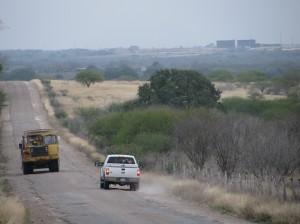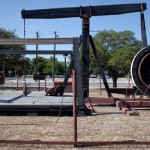How the Biggest Power Plant in Texas Will Use Pollution to Pump Oil
In past years, the W. A. Parish power plant outside Houston in Fort Bend County has ranked near the top of national lists for “Most Polluting Power Plants.” It has also been lauded for it’s efforts to reduce emissions.
Now, this power behemoth, the biggest power plant in Texas and second biggest fossil fuel-burning plant in the nation, is planning to build one of the country’s more innovative pollution control projects. It will use some of its pollution to pump oil out of the ground.
Plant owner NRG said it will begin construction next year of its “carbon capture” system. The system, made up of pipes and flues and sprayers, will be installed on one of the plant’s four coal-burning power generation units (four other units burn natural gas).
“This will be the first commercial-scale carbon capture on a power plant in the United States,” said Jeff Baudier, CEO of Petra Nova, NRG’s wholly-owned carbon capture business.
Here’s how it’s suppose to work: the W.A. Parish plant burns some 36,000 tons of coal a day, producing tons of carbon dioxide, a major greenhouse gas linked to climate change. The CO2 would normally go up and out the smokestacks. But now with the new system, the gas will be “captured” before it leaves the stack by spraying it with a chemical solvent. Then, the CO2 gas will be compressed and fed into a pipeline.
This is where what had been pollution becomes a way to produce oil.
The pipeline will run some 80 miles to the West Ranch Oil Field east of Victoria, Texas. There, the CO2 will be pumped a mile underground to expand oil deposited in rock formations, allowing the oil to be piped up to the surface.
This process of rejuvenating old oil fields by pumping in CO2 has been used for several decades, especially in West Texas. But getting the CO2 from a power plant is what’s new.
“From the technical side, there’s pretty good confidence we can do this,” said Michael Young, with the Bureau of Economic Geology at the University of Texas at Austin. The UT group has been partnering with the energy industry, including NRG, to research what the carbon dioxide will do when millions of tons of it is pumped thousands of feet underground.
“We’re way ahead of I think many of the other research groups nationally in showing that it’s feasible to do it.”
Young said one of their research projects is ongoing near Cranfield, Mississippi.
“We’ve been pumping a million tons a year underground and the systems are behaving as we expected them to. We’re using computer models to see where the CO2 is going,” said Young.
The goal is for 99% of the carbon dioxide to stay locked underground… forever. But not everyone is convinced it’ll work.

Dave Fehling/StateImpact Texas
Biggest power plant in Texas: the W.A Parish plant in Fort Bend County
“Anybody who’s independent enough and really worth their salt is never going to guarantee you that you can store this highly pressurized (CO2) underground for thousands of years and expect it to stay there,” said Ryan Rittenhouse with the environmental group Greenpeace. It’s backing a protest organization called Quit Coal.
Rittenhouse contends there is not enough research to determine if the CO2 won’t just leak back to the surface, defeating the whole idea of reducing greenhouse gases. Critics also have said there is the added worry that pumping such quantities deep into the ground might increase seismic activity or leak into underground water supplies, increasing the water’s alkalinity and causing other changes to degrade water quality.
Proposed projects to “sequester” carbon dioxide underground have met public opposition in other states, including Ohio, where one project was abandoned in 2009.
The U.S. Department of Energy is behind the power plant project, giving NRG $167 million in matching funds to build the project at the W.A. Parish station. The DOE said it wants to see if the carbon capture technology can be used in existing power plants in a way that makes it economically feasible.
Critics of coal have said it’s money that would be better spent on developing alternative energy sources.
NRG’s Jeff Baudier disagrees.
“We recognize that coal remains a very large part of the fuel source for electricity in the United States and it’s going to have to remain a very large part for years to come,” said Baudier.
“So our focus is not simply to dismiss coal as a fuel of the future, but to actually make it a clean fuel for the future.”
NRG hopes to have the new carbon-capture system in operation by early 2016.


